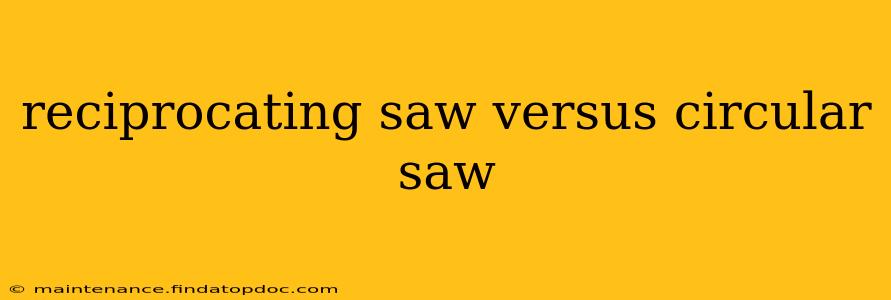Choosing between a reciprocating saw and a circular saw often boils down to the specific task at hand. Both are powerful tools, but their designs and capabilities make them better suited for different applications. This comprehensive guide will delve into the key differences, helping you determine which saw is the right choice for your needs.
What is a Reciprocating Saw?
A reciprocating saw, often called a "sawzall," is a versatile tool known for its ability to cut in tight spaces and handle various materials. Its reciprocating (back-and-forth) blade movement makes it ideal for demolition work, cutting curves, and working in confined areas where a circular saw would struggle. The blades are easily interchangeable, allowing for specialization based on the material being cut (wood, metal, plastic, etc.).
What is a Circular Saw?
A circular saw utilizes a spinning blade to make straight cuts, primarily in wood and other relatively soft materials. While some models can cut metal, they’re not as efficient or versatile in this regard as reciprocating saws. Circular saws excel at speed and precision for straight cuts, making them a staple in carpentry and woodworking projects. Their powerful motors allow for quicker cuts through thicker materials compared to reciprocating saws.
Reciprocating Saw vs. Circular Saw: Key Differences
| Feature | Reciprocating Saw | Circular Saw |
|---|---|---|
| Cut Type | Straight, curved, plunge cuts | Primarily straight cuts |
| Material | Wood, metal, plastic, drywall, etc. | Primarily wood, some metal |
| Maneuverability | High, excellent for tight spaces | Lower, best for open areas |
| Accuracy | Lower for straight cuts, higher for curves | Higher for straight cuts |
| Cutting Speed | Slower than circular saw for straight cuts | Faster than reciprocating saw for straight cuts |
| Power Source | Typically corded or cordless | Typically corded or cordless |
Which Saw is Right for Me?
The best saw depends entirely on your project.
-
Choose a reciprocating saw if:
- You need to cut curves or irregular shapes.
- You're working in tight spaces or confined areas.
- You need to cut through a variety of materials.
- You're performing demolition work.
-
Choose a circular saw if:
- You need to make precise, straight cuts in wood.
- Speed and efficiency are paramount.
- You're working on a larger project requiring many straight cuts.
What are the Advantages of a Reciprocating Saw?
Versatility: Reciprocating saws excel in versatility, handling various materials and cut types. This adaptability makes them an invaluable tool for various tasks.
Maneuverability: Their compact design and ability to cut in any direction makes them perfect for tight spaces and intricate cuts.
Plunge Cutting: Reciprocating saws can plunge cut, starting the cut from the middle of the material, a feature often not available with circular saws.
What are the Advantages of a Circular Saw?
Speed and Efficiency: For straight cuts in wood, circular saws are significantly faster and more efficient than reciprocating saws.
Accuracy (Straight Cuts): When used correctly, a circular saw can deliver highly accurate straight cuts.
Power: Circular saws generally have more powerful motors enabling quicker cuts through thicker materials.
What are some common uses for a reciprocating saw?
Reciprocating saws are commonly used for demolition, cutting pipes, trimming branches, and cutting through various materials in tight spaces. Their ability to handle metal makes them useful for many home repair and renovation projects.
What are some common uses for a circular saw?
Circular saws are primarily used for cutting wood in construction and woodworking. Common applications include cutting lumber for framing, making precise cuts for furniture construction, and cutting sheet goods such as plywood or MDF.
What type of blade should I use for my reciprocating saw?
The appropriate blade for a reciprocating saw depends on the material you're cutting. Different blades are designed for wood, metal, plastic, and other materials. Always choose a blade designed for the specific material you are cutting to ensure optimal performance and safety.
What type of blade should I use for my circular saw?
Circular saw blades are also material-specific. Blades with fine teeth are suitable for cleaner cuts in softer materials like wood, while blades with coarser teeth are better for rougher cuts or tougher materials. Tooth count and blade design significantly affect cutting quality and speed.
This comprehensive comparison should provide a clearer understanding of the differences between reciprocating and circular saws, ultimately aiding you in making the best choice for your next project. Remember safety always comes first, so always wear appropriate safety gear when operating any power tool.
